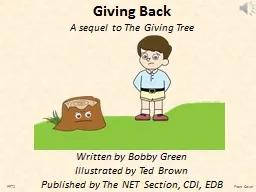PDF-The Effects of Giving on Givers In press 2011 Handbook of HealNicole R
Author : brooke | Published Date : 2021-10-05
Ever since the groundbreaking study by House Landis Umberson 1988 in which the tionships were equally important ealth as smoking has exploded An updated metaanalysis
Presentation Embed Code
Download Presentation
Download Presentation The PPT/PDF document "The Effects of Giving on Givers In press..." is the property of its rightful owner. Permission is granted to download and print the materials on this website for personal, non-commercial use only, and to display it on your personal computer provided you do not modify the materials and that you retain all copyright notices contained in the materials. By downloading content from our website, you accept the terms of this agreement.
The Effects of Giving on Givers In press 2011 Handbook of HealNicole R: Transcript
Download Rules Of Document
"The Effects of Giving on Givers In press 2011 Handbook of HealNicole R"The content belongs to its owner. You may download and print it for personal use, without modification, and keep all copyright notices. By downloading, you agree to these terms.
Related Documents














